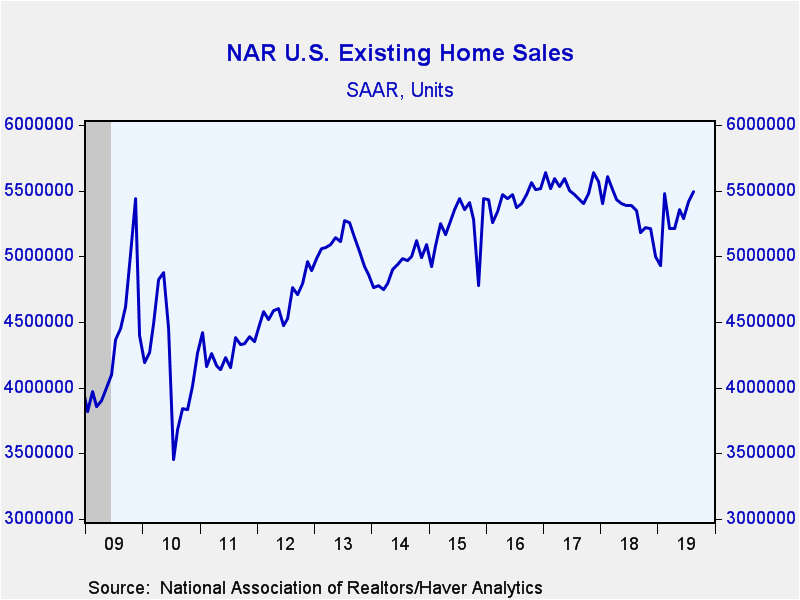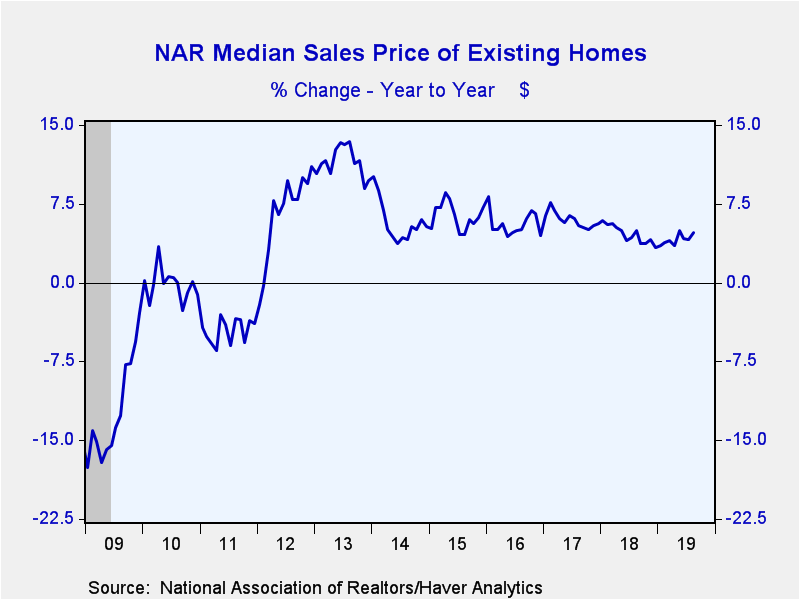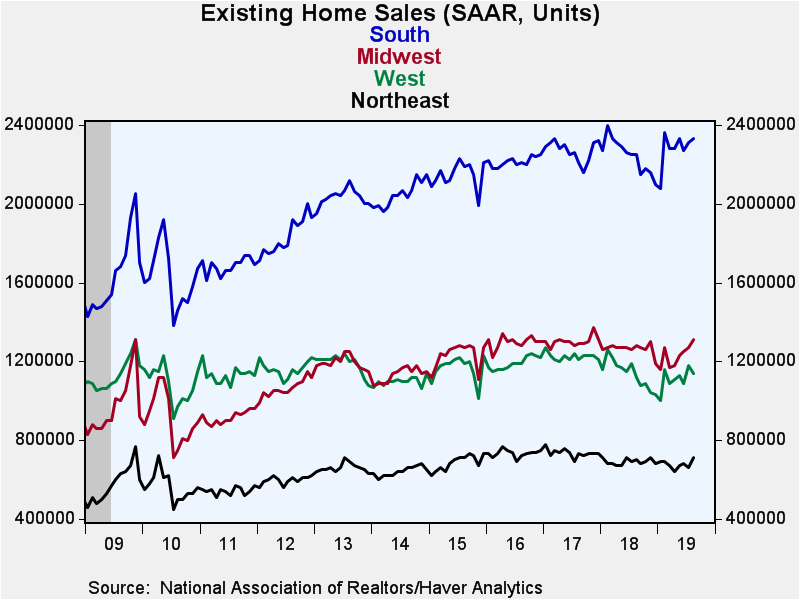 Global| Sep 19 2019
Global| Sep 19 2019U.S. Existing Home Sales Up Again in August
Summary
The National Association of Realtors (NAR) reported that sales of existing homes rose again in August, reaching 5.490 million, a 1.3% (2.6% y/y) increase from July's 5.420 million, which was unrevised and up 2.5% from June. The August [...]
The National Association of Realtors (NAR) reported that sales of existing homes rose again in August, reaching 5.490 million, a 1.3% (2.6% y/y) increase from July's 5.420 million, which was unrevised and up 2.5% from June. The August sales volume is the largest amount since 5.510 million in March 2018. The Action Economics Forecast Survey had expected August sales of 5.38 million.
The median price of all existing homes sold decreased again in August, by 0.8% to $278,200 (+4.7% y/y) following July's 1.7% decline. The average sales price fell 0.7% (+3.5% y/y) last month to $314,600. These price data are not seasonally adjusted, and declines during the summer months following a peak in June are not uncommon.
Existing home sales rose in three of the four major regions reported by NAR. The largest percentage gain was in the Northeast, 7.6% (+1.4% y/y), although that volume, 710,000 in August, is the smallest regional total. July sales there had fallen 2.9%. August sales in the Midwest rose 3.1% (+2.3% y/y) to 1.310 million after a July increase of 1.6%. Those in the South edged up 0.9% (+3.6% y/y) to 2.330 million after a 1.8% rise in July. The West was the one region with a decline in August, 3.4% (+1.8% y/y) to 1.140 million, but that followed a quite sizable 8.3% advance in July.
Nationwide, sales of existing single-family homes increased 1.2% (+2.9% y/y) to 4.900 million units, again the highest level since February's 4.910 million. Sales of condos and co-ops were rose 1.7% to 590,000 units (unchanged y/y).
The number of homes on the market declined 2.6% y/y. The months' supply of homes on the market fell again m/m to 4.1, but remained up from a low of 3.1 months in December 2017. In contrast, the peak months' supply in the aftermath of the Great Recession was 11.9 months in July 2010.
The data on existing home sales, prices and affordability are compiled by the National Association of Realtors and can be found in Haver's USECON database. The regional price, affordability and inventory data are available in the REALTOR database. The expectations figure is from the Action Economics Forecast Survey, reported in the AS1REPNA database.
| Existing Home Sales (SAAR, 000s) | Aug | Jul | Jun | Aug Y/Y % | 2018 | 2017 | 2016 |
|---|---|---|---|---|---|---|---|
| Total | 5,490 | 5,420 | 5,290 | 2.6 | 5,341 | 5,531 | 5,437 |
| Northeast | 710 | 660 | 680 | 1.4 | 689 | 735 | 733 |
| Midwest | 1,310 | 1,270 | 1,250 | 2.3 | 1,265 | 1,301 | 1,297 |
| South | 2,330 | 2,310 | 2,270 | 3.6 | 2,246 | 2,270 | 2,215 |
| West | 1,140 | 1,180 | 1,090 | 1.8 | 1,141 | 1,225 | 1,192 |
| Single-Family | 4,900 | 4,840 | 4,710 | 2.9 | 4,742 | 4,907 | 4,822 |
| Median Price Total ($, NSA) | 278,200 | 280,400 | 285,300 | 4.7 | 257,267 | 245,950 | 232,067 |
Carol Stone, CBE
AuthorMore in Author Profile »Carol Stone, CBE came to Haver Analytics in 2003 following more than 35 years as a financial market economist at major Wall Street financial institutions, most especially Merrill Lynch and Nomura Securities. She has broad experience in analysis and forecasting of flow-of-funds accounts, the federal budget and Federal Reserve operations. At Nomura Securites, among other duties, she developed various indicator forecasting tools and edited a daily global publication produced in London and New York for readers in Tokyo. At Haver Analytics, Carol is a member of the Research Department, aiding database managers with research and documentation efforts, as well as posting commentary on select economic reports. In addition, she conducts Ways-of-the-World, a blog on economic issues for an Episcopal-Church-affiliated website, The Geranium Farm. During her career, Carol served as an officer of the Money Marketeers and the Downtown Economists Club. She has a PhD from NYU's Stern School of Business. She lives in Brooklyn, New York, and has a weekend home on Long Island.









